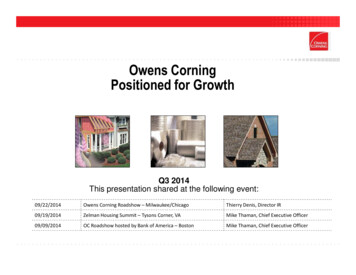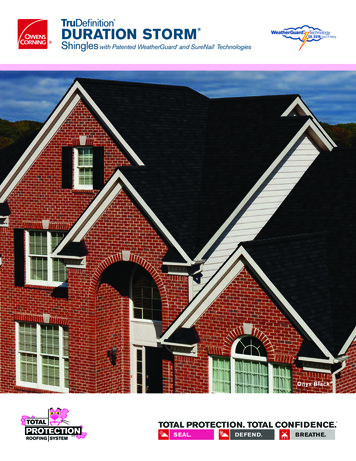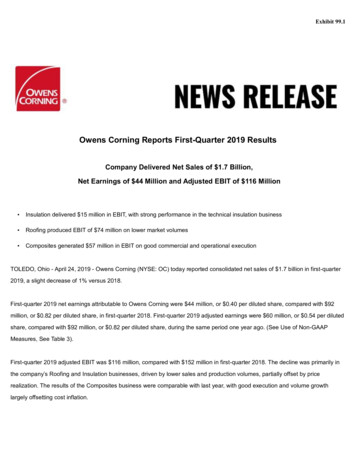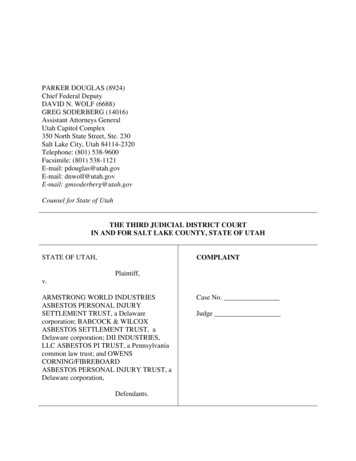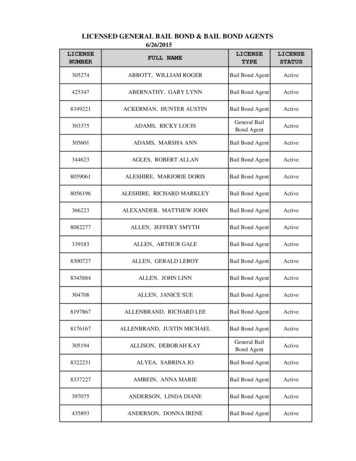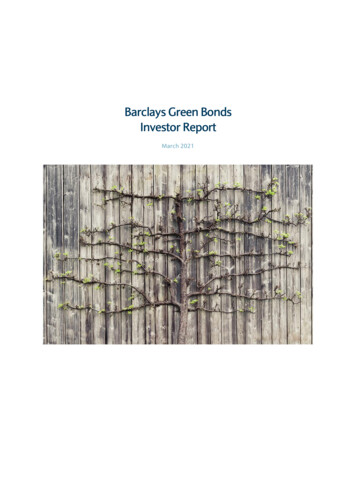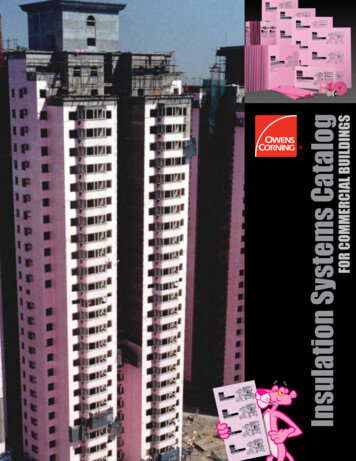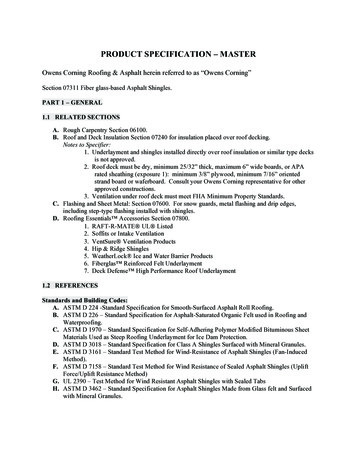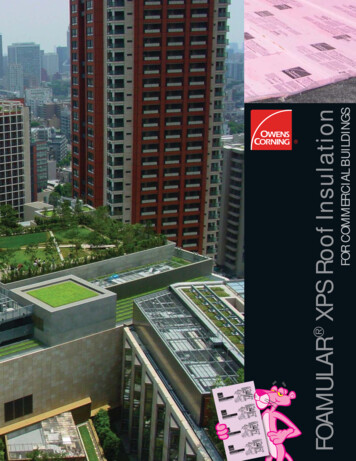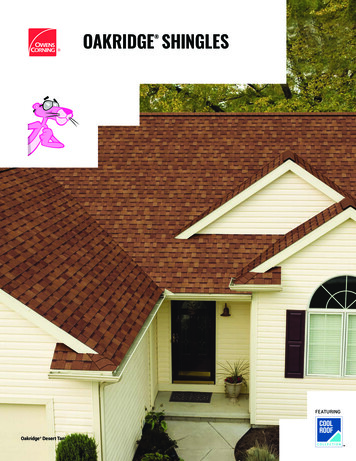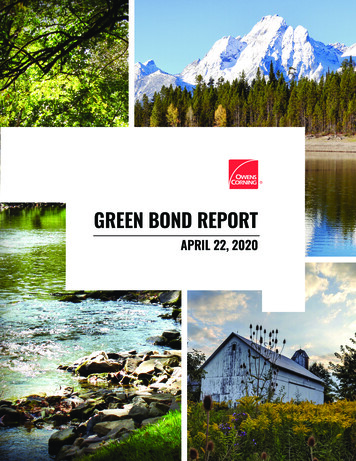
Transcription
GREEN BOND REPORTAPRIL 22, 2020
INAUGURAL GREEN BOND 450mm3.95% 445mm 481mmbond payable overto be spent on eligible10 yearscoupon rategreen projectsallocated to eligible greenprojects as of January 31, 2020INTRODUCTIONIn August 2019, Owens Corning completed the issuance of ourinaugural green bond, in keeping with our aspiration to be a netpositive company whose handprint is greater than its footprint.This 450 million bond is payable over 10 years at a couponrate of 3.95%. In conjunction with the bond, the company hascommitted to spend 445 million on eligible green projects.The committed funds are being used to further the company’swork in renewable energy, energy efficiency, and eco-efficient andcircular economy-adapted products, production technologies andprocesses. Eligible projects include: Long-term power purchase agreements for renewable energy,including investments in solar and wind power generationfacilities. Investments to increase energy efficiency in internal projectsand processes, particularly those that are energy intensive. Investments in eco-efficient programs to substantially reducewaste or to increase recycling, such as by increasing the levelof recycled material in our products.Additionally, funds are being used for projects that benefitcustomers and consumers, through research and developmentof products that support the same categories. Eligible projectsalso include capital expenditures related to the manufacturingof insulation, which improves energy efficiency in buildings andindustrial processes, and glass fiber and fabric used in windturbine blades.Project SelectionSeveral teams in the company collaborated to select projects forthe allocation of green bond proceeds. Projects were selectedbased on the following factors: Alignment with eligibility criteria disclosed within theProspectus Supplement. Consistency with Corporate sustainability objectives andtargets. Feasibility of tracking project expenditures. Allocation of funds within the eligible period (during the periodthat begins 24 months prior to the issuance of the bond andends on the maturity date of the bond).We selected the eligible projects noted below based on thesecriteria.Project Evaluation and ResultsIn the three categories of eligible projects, we definedperformance indicators that align with the way we report ourprogress in our annual sustainability report, which is available atwww.owenscorning.com/sustainability. The projects supportedby the bond will help us advance toward our ambitious 2030footprint reduction goals.As outlined in the Green Bond Principles, we committed toreporting on how the committed funds are spent and theprogress on the initiatives outlined in the Prospectus Supplementdelivered in connection with the issuance of the bond. Weare pleased to share this information with our investors andstakeholders in these pages.2
RENEWABLE ENERGY –Allocated 88.3mmTo measure performance of our projects in this category, wemeasured installed capacity and estimated energy generation forrenewable energy power purchase agreements. For example, wemeasure the number of gigawatts of wind capacity that our glassreinforced fabrics business supports. Our projects in the renewableenergy category fall into the following areas:1.Purchases of renewable energy pursuant to long-term powerpurchase agreements which we have entered into prior tocommercial operation of the related facility.2. Capital expenditures related to glass fiber, and glass fabricmanufacturing of components, for use in wind energy blades,as well as associated research and development.3.Investments that enable the development, construction,and operation of solar and wind power generation facilities,including investments in transmission and storageinfrastructure to support these facilities.Energy Power Purchase AgreementsOne of our ambitious sustainability goals for 2030 is to switch to100% renewable electricity, in support of our aspiration to use onlyrenewable energy. In 2019, approximately 49% of our electricitycame from renewable sources, such as wind, hydro, solar, andgeothermal, across our portfolio globally. This includes renewableenergy sourced from the grid as well as that enabled by our powerpurchase agreements, including on-site generation. While the totalfor 2019 reflects benefits from projects not covered by the use ofproceeds from this bond, the proceeds have supported many of theprojects that are key to meeting our goal.In recent years, Owens Corning has expanded its renewable energyportfolio in an effort to reduce our greenhouse gas emissions. Thepower purchase agreements we signed in 2015 enabled new windcapacity in Texas and Oklahoma. Both wind farms came online inlate 2016 and have the potential to generate 1.1 million megawatthours of electricity per year. Through our power purchaseagreements for wind, Owens Corning retired 976,897 renewableenergy credits against our indirect emissions for a total of 479,997metric tons of avoided CO2e emissions in 2019.Other Renewable Energy Projects In Toledo, Ohio, a 2.4-megawatt solar array providedapproximately 20% of the power for our world headquarters. The 2.7-megawatt solar panels installed at our Delmar, NewYork, insulation plant provided approximately 8% of its requiredelectricity. The Kearny, New Jersey, roofing plant sourced around 5% of itsrequired electricity from roof solar panels.These projects were initiated before the period covered by ourgreen bond reporting period. Only the proceeds from the bondsused for the covered years is included in our eligible projects andour reporting.Investments to Support Growth in Wind EnergyOwens Corning’s glass-reinforced composite materials are used tomake thousands of products stronger, lighter, and more durable.We primarily sell our composites products directly to parts moldersor fabricators, including the makers of wind turbine blades. Ourmaterials are used to enable longer, stronger, lighter blades,which brings down the cost of wind energy. Owens Corning usedproceeds from the bond to support the growth of wind energythrough investments in high-modulus glass and weaving capacityand capabilities.For example, we used proceeds to expand capacity in our Taloja,India, glass manufacturing plant, to enable increased production ofhigh-modulus glass rovings for our Ultrablade high-performancefabrics. Fabrics reinforced with high-modulus glass feature apowerful combination of optimized design, high performance, andultimate reliability. This material enables customers to producelonger wind turbine blades that can be up to 6% lighter than thosemade from traditional glass fabrics.Proceeds from the bond also supported our investment in capacityadditions and infrastructure improvements in our downstreamtechnical fabrics manufacturing facilities in the United States,Russia, India and China. We believe the investments will generateimproved productivity in high-modulus solutions and a simplifiedsupply chain, which we expect will lower the cost of wind energyand increase our customers’ productivity.3
ENERGY EFFICIENCY –Allocated 199.3mmWe measure energy efficiency by evaluating the reduction of energy intensity in our manufacturing operations, pounds of insulation produced,and the respective energy benefits of these projects. Our projects in the energy efficiency category fall into the following areas:1.Capital expenditures related to manufacturing of insulation, which improves the energy efficiency of buildings and industrial processes, aswell as associated research and development.2. Investments in process and materials innovation intended to increase energy efficiency in our internal projects and processes, particularlythose that are energy-intensive.Expansion of Our Paroc Facility in PolandOwens Corning acquired Paroc Group, one of Europe’s leadingmanufacturers in the field of energy-efficient stone wool insulation,in 2018. The acquisition was part of a strategic goal to broaden ourcompany’s product portfolio and diversify our geographic scope tobetter address our customers’ needs and support their growth.The acquisition of Paroc means that Owens Corning now has aleading position in the European and global mineral wool markets.Paroc finished construction of a new energy-efficient line inTrzemeszno, Poland, in 2019. The upgrade of this productiontechnology supports our growth strategy for Central and WesternEurope and further expands our current operational capabilities.We expect to reduce our CO2 emission by 75% to 80% with this linecompared to a traditional coke-fired furnace line. Moreover, thenew line’s Electric Arc Furnace (EAF) is expected to reduce carbonintensity* by roughly 10% for all Paroc Insulation in Europe. Thenew EAF is the third stone wool electric furnace for Owens Corningin Europe and the second on the Owens Corning site in Poland.Supporting Manufacturing Capacity for EnergySaving ProductsOwens Corning insulation products are designed to save energyin buildings. Fiberglass insulation is the most widely used type ofinsulation in the United States, Canada, and Mexico today. A typicalpound of fiberglass insulation saves 12 times as much energy in itsfirst year in place as the energy used to produce it. That means theenergy consumed during manufacturing is saved during the firstfour or five weeks of product use. The insulation continues to savethat amount of energy every month throughout the life of the homeor building in which it is installed.Energy efficiency projects in our facilities around the world improveOwens Corning’s energy-use profile and improve the life cycleenergy-saving benefit of our products for our customers.* Carbon intensity is the CO2 emissions per unit of product.Select 2017-2019 Energy Efficiency ProjectsEstimated annual CO2e savings(metric tons CO2e)Lighting projects focused on improving energy efficiency of lighting in various manufacturing plantsacross the U.S., Canada, China and Europe.20,633Energy efficiency projects of various types across the U.S., Canada, China, Brazil, Europe, and SouthKorea, including pump upgrades, motor upgrades, VFD upgrades, HVAC upgrades, compressed air andenergy monitoring system improvements15,766Projects across the U.S., Canada, Brazil, Italy, and France impacting our processes, resulting in energyefficiency and operational improvements, including new metering systems, peak demand management,steam distribution system improvements, process equipment upgrades, and system automation andoptimization6,501Waste heat recovery projects focused on improving the energy efficiency of process heat systems inplants in U.S., China, Canada, Mexico, India, France, Netherlands and South Korea.13,317Total: 56,2174
ECO-EFFICIENT AND/OR CIRCULARECONOMY ADAPTED PRODUCTS –Allocated 193.2mmFor the third category of eligible projects, we measured weightedintensity of recycled products and percent of recycled content.These projects correspond to these actions:1.Purchases of waste materials (including, without limitation,waste glass or cullet) for use, or investments that enable us touse recycled materials, in our processes and product2.Capital expenditures and associated research anddevelopment that support end-of-life, beneficial-use solutionsfor our core products and applications3.Capital expenditures and associated research anddevelopment related to products that save or conserveresources, including products that meet at least one of thefollowing criteria:a.Incorporate recycled and/or bio-based, or renewablecontent.b.Are recyclable or reusable or have a sustainablealternative use.c.Have low embodied carbon relative to alternatives.Recycled Glass in Owens Corning FiberglassInsulationWe are one of the largest users of recycled glass in the world,using well over one billion pounds annually of curbside consumercontainers and pre-consumer recycled glass for our insulationbusiness. Using recycled glass decreases community landfillwaste, and lowers our energy use associated with manufacturinginsulation because starting with raw materials such as sandrequires more energy.Owens Corning is a leader in recycled content for fiberglassinsulation, ranging from a minimum of 53% recycled content to ahigh of 73% recycled content in our Canadian-made products. Wealso have a high level of certified post-consumer content in ourlight-density building insulation. Our North American residentialfiberglass insulation is certified by SCS Global Services to containat least 55% recycled content, while our commercial and industrialfiberglass insulation is certified to have a minimum of 53%recycled content.Recycled Materials in Owens Corning MineralWool and XPS Foam InsulationBoth our Thermafiber mineral wool insulation and XPS foaminsulation in North America also use recycled materials in themanufacturing process. We used proceeds from the bond topurchase blast furnace slag for Thermafiber mineral woolinsulation and recycled resin for the XPS foam business. Blastfurnace slag is a byproduct of the iron smelting process and allowsfor lower energy use in the manufacturing process because it meltsat lower temperatures. Our Thermafiber mineral wool insulationis manufactured to have a minimum of 70% recycled content andis validated by ICC Evaluation Services. Our XPS foam insulationin North America has 20% certified pre-consumer plastic. Thematerial includes polystyrene from industrial sources such asbeads and pellets derived primarily from food service containersand protective packaging that would otherwise be landfilled, whichreduces the need for virgin resin.ConclusionWe are privileged to have the support of our investors throughthis bond, as we work to achieve our environmental footprintreduction goals. Sustainability is central to our business, throughthe products we make and the way we make them. The exampleprojects described in this report are only a few of the ways we’restriving to fulfill our aspirations, and we invite you to learn moreabout our sustainability progress and commitments in our 2019Sustainability Report, available atwww.owenscorning.com/sustainability.*View Report of Independent st-Report.pdf* The information on our website, including our Sustainability Report, is not,and will not be deemed to be, a part of this Report. 2020 Owens Corning. All Rights Reserved.5
In August 2019, Owens Corning completed the issuance of our inaugural green bond, in keeping with our aspiration to be a net-positive company whose handprint is greater than its footprint. This 450 million bond is payable over 10 years at a coupon rate of 3.95%. In conjunction with the bond, the company has
